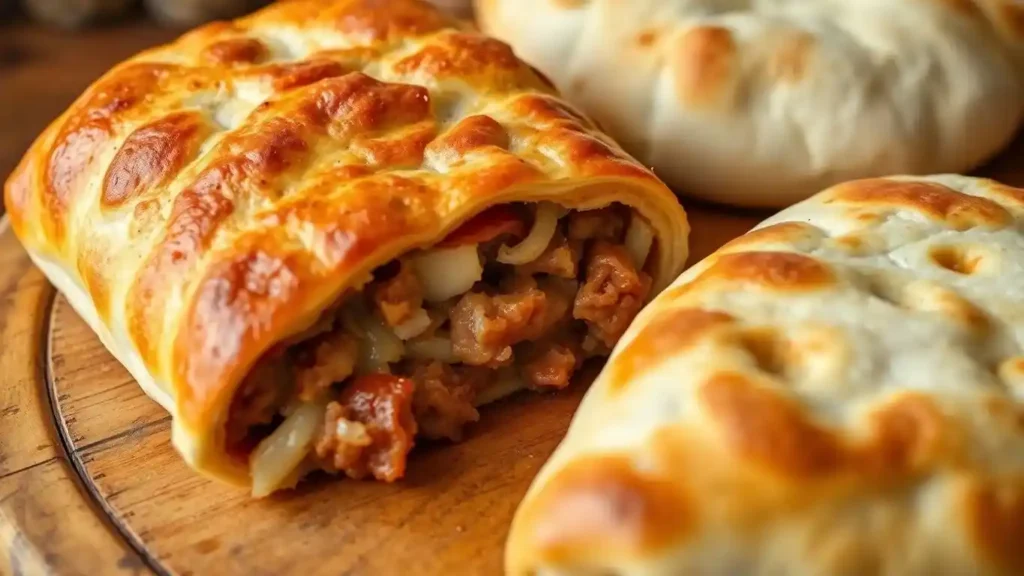When it comes to Italian-inspired comfort food, stromboli and calzone are two of the most popular choices. While they might look similar at first glance, their origins, preparation, and presentation set them apart. A stromboli, an Italian-American creation, is rolled like a savory pinwheel, while a calzone, which hails from Naples, is a folded, pizza-like pocket.
Beyond their structural differences, the fillings, sealing methods, and serving styles of these dishes also vary. Whether you’re dipping into marinara sauce with a calzone or slicing up a stromboli to share, each dish offers a unique way to enjoy cheesy, doughy goodness. In this article, we’ll break down the key differences between stromboli and calzone, from their history and ingredients to their cooking techniques and serving styles, helping you choose the perfect option for your next meal.
Table of contents
Origins of Stromboli and Calzone

Stromboli’s Italian-American Roots
Stromboli has a unique place in the culinary world, emerging from the vibrant Italian-American communities in Philadelphia during the 1950s. Unlike its Italian counterpart, the calzone, stromboli was crafted in the United States, inspired by the flavors and traditions brought over by Italian immigrants. It was named after the Italian Isle of Stromboli, which is famous for its active volcano. This dish quickly became a staple in Italian restaurants across America, known for its rolled, cylindrical shape that is often filled with a variety of Italian cheese, meats, and sometimes vegetables like spinach stromboli.
Calzone’s Neapolitan Beginnings
Calzones, on the other hand, trace their origins back to Naples, Italy, in the 18th century. Originally designed as a portable meal, calzones were crafted to be a convenient way to enjoy pizza on the go. These crescent-shaped delights are typically filled with ingredients similar to pizza, such as mozzarella and ricotta cheese, and are sealed by folding the dough over itself. This method of preparation highlights the traditional Italian approach to creating hearty, flavorful dishes that can be enjoyed anywhere.
Cultural Significance of Both Dishes
Both stromboli and calzone hold significant places in their respective cultures. Stromboli represents the fusion of Italian tradition with American innovation, showcasing the adaptability and creativity of Italian immigrants. Meanwhile, the calzone remains a classic example of Neapolitan street food, embodying the rich culinary history of Italy. The difference between stromboli and calzone is not just in their preparation but also in their cultural narratives, as each dish reflects the unique journey of its creators.
The stories of stromboli and calzone are not just about food, but about the blending of cultures and the evolution of culinary traditions. Each bite tells a tale of history, migration, and the enduring love for Italian flavors.
Sealing Techniques: Stromboli vs Calzone

How Stromboli is Sealed
Stromboli’s sealing technique is all about the roll. You start with a rectangle of pizza dough, layer on the fillings, and then roll it up like a burrito. The dough itself creates a natural seal, but many cooks add an egg wash for extra security, especially around the edges. This wash not only helps keep the fillings inside but also gives the stromboli a nice golden finish. The ends are often left open, allowing the heat to circulate and cook everything evenly.
Calzone’s Unique Folding Method
Calzones, on the other hand, embrace a folding method that gives them their classic half-moon shape. You begin with a circle of dough, add your favorite fillings—often including ricotta and mozzarella cheese—and then fold it over. The edges are crimped tightly, sometimes with the help of a fork, to ensure nothing leaks out during baking. An egg wash is usually brushed on top, not just for sealing but also to give the crust a beautiful sheen. Unlike stromboli, calzones are typically sealed all around, with small slits cut on top to let steam escape.
Role of Egg Wash in Sealing
Egg wash plays a crucial role in both stromboli and calzone preparation. It’s a simple mixture of beaten eggs, sometimes with a splash of water or milk, that acts as a glue to hold the dough together. For stromboli, it helps secure the rolled dough, while for calzones, it ensures the crimped edges stay sealed during baking. Besides its sealing properties, egg wash enhances the visual appeal by giving the crust a shiny, golden-brown finish.
The difference between calzone and stromboli isn’t just in their shape or size, but in how they’re sealed. This simple step defines their texture and eating experience, making each bite a distinct delight.
Shape and Size Differences between a Stromboli and a Calzone
Stromboli’s Cylindrical Form
Stromboli stands out with its cylindrical shape, resembling a rolled-up pizza. Made by rolling pizza dough into a large rectangle, it’s filled with various ingredients before being rolled into a tight cylinder. This shape not only makes it visually distinct but also allows it to be sliced into portions, making it perfect for sharing. Unlike calzones, strombolis are often larger and can serve multiple people.
Calzone’s Crescent Shape
Calzones, on the other hand, are known for their iconic “moon shape.” The dough is stretched into a circle, filled on one side, and then folded over to create a half-moon. This method of folding gives the calzone its unique appearance and makes it a convenient, handheld meal. Typically, calzones are individual-sized, making them a personal pizza pocket.
Serving Sizes Compared
When it comes to serving sizes, there is a primary difference: strombolis are generally larger and intended to be sliced and shared, while calzones are usually single-serving. This slight difference in size also influences how each dish is enjoyed, with strombolis being a crowd-pleaser at gatherings and calzones offering a personal dining experience.
Traditional Fillings and Ingredients

Cheese Choices: Mozzarella vs Ricotta
When it comes to cheese, strombolis and calzones each have their own signature. Stromboli almost always features mozzarella cheese, known for its mild flavor and excellent melting properties. This choice keeps the filling creamy without being overly moist. On the other hand, calzones traditionally incorporate ricotta cheese, which gives them a rich, creamy texture. Often, you’ll find a blend of mozzarella and ricotta in calzones, balancing moisture and flavor.
Meat and Vegetable Options
Both stromboli and calzone can be filled with a variety of meats and vegetables, making them versatile dishes. Common fillings include:
- Deli meats such as salami, ham, and pepperoni, which add a savory depth.
- Vegetables like spinach, mushrooms, and bell peppers, providing freshness and color.
- Herbs such as basil and oregano to enhance the overall flavor profile.
Sauce Placement and Variations
Sauce plays a different role in each of these dishes. In stromboli, sauce is often either included inside or served on the side, allowing for a neat, less messy experience. Calzones, however, traditionally keep the sauce on the side, perfect for dipping each bite. This difference in sauce placement can significantly alter the eating experience, with stromboli offering a more integrated taste and calzones providing a customizable dipping option.
Choosing between a stromboli and a calzone often comes down to personal preference in cheese and sauce placement. Both offer a delightful combination of flavors and textures, making them favorites in Italian-American cuisine.
For those watching their diet, it’s good to note the caloric content of these dishes. A Buffalo chicken stromboli can be particularly calorie-dense, so pairing it with lighter sides like salads might be a good balance.
Cooking Methods for Stromboli and Calzone
Baking Techniques
For both stromboli and calzone, baking is the go-to method. Stromboli is typically baked in a moderately hot oven, around 350°F, for about 20 minutes. This allows the dough to cook evenly and the fillings to heat through without burning the crust. It’s crucial to roll the pizza dough properly to avoid any bursting during baking. A few pricks with a fork can help release trapped air, ensuring a neat roll.
Calzones, on the other hand, are usually baked at a higher temperature, similar to pizza. This high heat quickly crisps the outside while keeping the inside soft and melty. The dough is folded over the fillings, creating a half-moon shape, and it’s often brushed with egg wash for a glossy finish. Baking time is shorter, around five minutes, due to the intense heat.
Frying Calzones: The Panzerotti
In Italy, calzones have a fried variant known as panzerotti. This method involves deep-frying the dough until golden brown. The frying process gives these Italian dishes a unique texture—crispy on the outside and soft inside. When frying, it’s important to maintain the crescent shape by pulling the edges before placing them in the fryer. This method is less common in the U.S., where baked calzones are more popular.
Temperature and Time Considerations
When preparing stromboli and calzone, temperature and timing are key. Stromboli requires a lower temperature to ensure the dough cooks through without the fillings drying out. For calzones, the high heat of a pizza oven ensures a quick bake, sealing in the flavors and moisture.
Whether you choose to bake or fry, both methods offer a delightful twist on the traditional pizza dough, allowing for creative fillings like Buffalo Chicken Stromboli or classic Italian meats and vegetables like bell peppers. Serve with a side of warm tomato sauce for dipping and enjoy these delicious Italian-American dishes fresh from the oven or fryer.
Serving Suggestions and Pairings
Dipping Sauces and Sides
Strombolis and calzones are often served with a variety of sauces for dipping, elevating the dining experience to new heights. Marinara is a classic choice, but why not try something different like a spicy arrabbiata or a creamy garlic sauce? These can be the perfect appetizer when paired with a fresh salad drizzled with olive oil or a side of roasted vegetables. For meat lovers, adding a side of delicious meats like Italian sausage or prosciutto can make the meal even more satisfying.
Presentation Styles
When it comes to presenting these Italian favorites, creativity goes a long way. Slice strombolis into manageable pieces for easy sharing, making them ideal food for parties. Calzones, on the other hand, can be served whole or halved, showcasing their beautiful crescent shape. Garnishing with fresh herbs or a sprinkle of parmesan cheese not only adds flavor but also enhances the visual appeal.
Pairing with Beverages
Pairing the right beverage with your stromboli or calzone can transform the meal. A robust red wine complements the rich flavors, while a crisp white can balance the cheese and meats. For non-alcoholic options, consider a sparkling water with a splash of lemon or a refreshing iced tea. These pairings can turn your favorite recipes into a memorable dining experience.
Whether you’re enjoying a quiet dinner at home or hosting a lively gathering, strombolis and calzones offer versatility and flavor that cater to everyone’s tastes. Their adaptability to different fillings and pairings ensures there’s something for every palate, making them a staple in any kitchen.
Popularity and Modern Variations
Stromboli and Calzone in American Cuisine
Stromboli and calzone have become staples in American cuisine, each offering a unique twist on traditional Italian flavors. The stromboli, an American creation, often features a variety of fillings like meats and cheeses rolled up in dough, making it a versatile option for gatherings. Calzones, on the other hand, are typically filled with ricotta and mozzarella, folded into a half-moon shape. Both dishes have found a special place in the hearts of Americans, thanks to their rich flavors and satisfying textures.
Creative Twists on Traditional Recipes
Over the years, chefs and home cooks alike have experimented with these classic dishes, leading to innovative variations. Some popular twists include:
- Incorporating international flavors, like adding Mexican spices or Asian ingredients.
- Creating dessert versions with sweet fillings like chocolate or fruit.
- Offering gluten-free or vegan options to cater to different dietary needs.
Influence of Regional Ingredients
Regional ingredients have played a significant role in how strombolis and calzones are made across the U.S. In coastal areas, seafood might be a common addition, while in the Midwest, local cheeses or meats could be featured prominently. This adaptation to local tastes has only increased their popularity, making them a favorite choice for those seeking comfort food with a touch of personal preference.
The beauty of strombolis and calzones lies in their adaptability. Whether you’re sticking to the classics or trying something new, there’s a version out there for everyone.
Wrapping It Up: Stromboli vs. Calzone
So, there you have it. Strombolis and calzones might look similar at first glance, but they’re definitely not the same. Think of a calzone as a pizza’s cousin from Italy, all folded up and ready to go, while a stromboli is its American-born relative, rolled up and sliced for sharing. The way they’re sealed, their shapes, and even their origins set them apart. Next time you’re at a pizzeria, you’ll know exactly what you’re getting into. Whether you go for the half-moon calzone or the rolled-up stromboli, you’re in for a tasty treat. Just don’t mix them up, or you might get a few funny looks from the pizza purists out there!
Frequently Asked Questions
What is the main difference between a stromboli and a calzone?
The biggest difference is how they are sealed. A stromboli is rolled like a burrito, while a calzone is folded like a taco.
Where did strombolis and calzones originate?
Calzones came from Naples, Italy. Strombolis were created in Philadelphia, USA.
What shapes are strombolis and calzones?
Strombolis are shaped like long cylinders, and calzones are shaped like half-moons.
What kind of cheese is usually in a calzone?
Calzones often have ricotta cheese, sometimes mixed with mozzarella.
How are strombolis and calzones typically cooked?
Both are usually baked, but calzones can also be fried.
Do strombolis and calzones contain sauce inside?
Calzones are typically served with sauce on the side, while strombolis might have sauce inside or also on the side.
